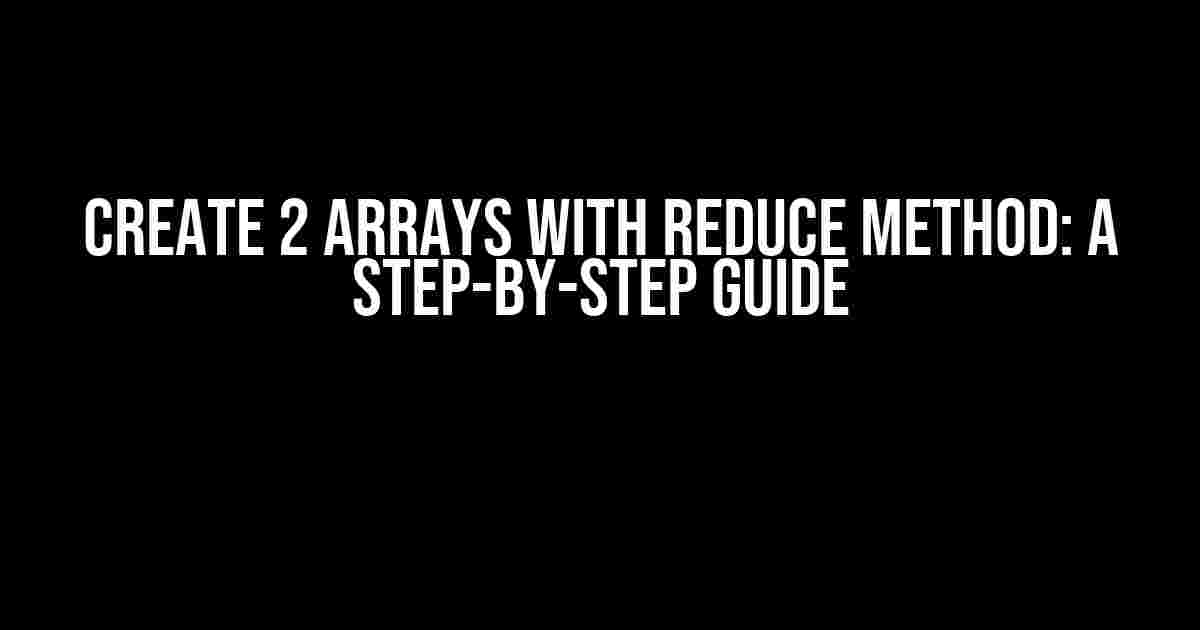Are you tired of struggling to create multiple arrays using the reduce method? Do you find yourself stuck in a loop, unsure of how to approach this seemingly complex task? Fear not, dear developer, for today we’re going to tackle this challenge head-on and emerge victorious!
What is the Reduce Method?
Before we dive into creating 2 arrays with the reduce method, let’s take a quick detour to understand what this method is all about. The reduce method is a part of the Array.prototype in JavaScript, which allows you to reduce an array to a single value. Yeah, you read that right – single value! But don’t worry, we’ll work our magic to create not one, but two arrays using this method.
const arr = [1, 2, 3, 4, 5];
const sum = arr.reduce((acc, current) => acc + current, 0);
console.log(sum); // Output: 15In the above example, we’re using the reduce method to calculate the sum of all elements in the array. The reduce method takes a callback function as an argument, which is called for each element in the array. The callback function takes two arguments: the accumulator (acc) and the current element. The accumulator is the value returned in the previous iteration, and the current element is the current element being processed.
Creating 2 Arrays with Reduce Method
Now that we’ve covered the basics, let’s get to the good stuff! Creating two arrays with the reduce method is a bit more complex, but trust us, it’s worth the effort. We’ll use an example to illustrate the process.
const arr = [
{ id: 1, name: "John", age: 25 },
{ id: 2, name: "Jane", age: 30 },
{ id: 3, name: "Bob", age: 35 },
{ id: 4, name: "Alice", age: 20 },
{ id: 5, name: "Charlie", age: 28 }
];
const [ages, names] = arr.reduce((acc, current) => {
acc[0].push(current.age);
acc[1].push(current.name);
return acc;
}, [[], []]);
console.log(ages); // Output: [25, 30, 35, 20, 28]
console.log(names); // Output: ["John", "Jane", "Bob", "Alice", "Charlie"]In this example, we’re creating two arrays: one for ages and one for names. We’re using the reduce method to iterate over the original array and push the age and name properties to their respective arrays.
How it Works
Let’s break down the code to understand what’s happening:
- We initialize the accumulator (acc) with two empty arrays `[[], []]`. This will be the container for our two resulting arrays.
- In the callback function, we push the current element’s age to the first array (`acc[0]`) and the name to the second array (`acc[1]`).
- We return the accumulator at the end of each iteration, so it can be used in the next iteration.
- The final result is an array of two arrays, which we destructure into `ages` and `names` variables.
Benefits of Creating 2 Arrays with Reduce Method
So, why would you want to create two arrays using the reduce method? Here are some benefits:
- Efficient**: Reduce method is a single iteration over the original array, making it more efficient than using two separate loops.
- Concise**: The code is concise and easy to read, making it perfect for situations where you need to perform multiple operations on an array.
- Flexible**: You can create multiple arrays based on different properties or conditions, making it a versatile solution.
Common Use Cases
Creating two arrays with the reduce method is useful in various scenarios:
| Use Case | Description |
|---|---|
| Grouping Data | Grouping data by a specific property, such as categories or dates, and creating separate arrays for each group. |
| Data Manipulation | Performing data manipulation, such as extracting specific values or converting data types, and creating separate arrays for each operation. |
| Data Analysis | Analyzing data by creating separate arrays for different metrics, such as averages, sums, or counts. |
Conclusion
And there you have it! Creating two arrays with the reduce method is a powerful tool in your JavaScript arsenal. By following this step-by-step guide, you’ll be able to tackle even the most complex array manipulation tasks with ease. Remember, the key is to think outside the box and get creative with your callback functions.
So, the next time you’re faced with the challenge of creating multiple arrays, don’t panic – just reduce, baby, reduce!
Happy coding!
Here are 5 Questions and Answers about “Create 2 arrays with reduce method” in a creative voice and tone:
Frequently Asked Question
Get ready to unleash the power of reduce method and create not one, but two arrays like a pro!
Can I really create two arrays with the reduce method?
Absolutely! The reduce method is not limited to creating a single output. You can use it to create two arrays by returning an object with two properties, each holding an array.
How do I initialize the two arrays in the reduce method?
Easy peasy! You can initialize the two arrays as empty arrays in the initial value of the reduce method. For example, `array.reduce((acc, current) => { … }, { array1: [], array2: [] });`.
Can I use the reduce method to create two arrays with different conditions?
You bet! You can use the reduce method to create two arrays based on different conditions by using if-else statements or conditional operators inside the reduce callback function. For example, `array.reduce((acc, current) => current > 5 ? acc.array1.push(current) : acc.array2.push(current), { array1: [], array2: [] });`.
What if I want to create two arrays with objects that have different properties?
No problem! You can create two arrays with objects that have different properties by using the reduce method to create objects with the desired properties and then pushing them to the respective arrays. For example, `array.reduce((acc, current) => { acc.array1.push({ id: current }); acc.array2.push({ name: current }); return acc; }, { array1: [], array2: [] });`.
Is the reduce method the most efficient way to create two arrays?
While the reduce method is a great way to create two arrays, it may not be the most efficient way, especially for large datasets. In such cases, using a simple loop or other methods like `forEach` or `filter` might be more efficient.






![Salutations not getting removed within jQuery statement [duplicate] Salutations not getting removed within jQuery statement [duplicate]](https://vincenc.hkhazo.biz.id/wp-content/uploads/sites/144/2024/07/salutations-not-getting-removed-within-jquery-statement-duplicate-with-text-300x300.jpg)